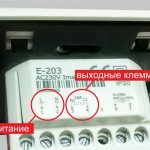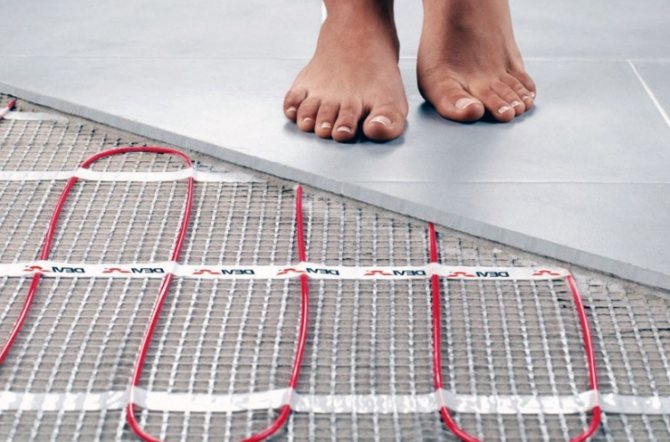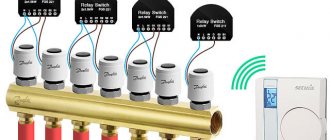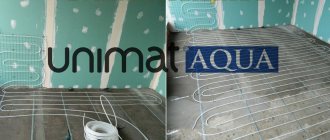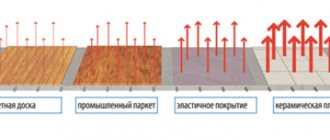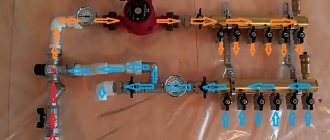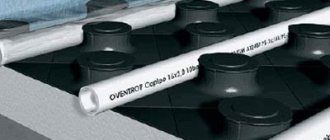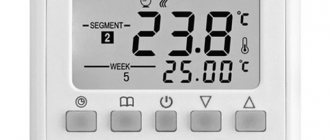Underfloor heating has become a very popular heating method in recent years. It is laid in all types of premises: living rooms, bathrooms and toilets, kitchens and balconies. If in private housing construction there are no installation bans, then in apartment buildings it is allowed to use only electric floor heating. This is due to frequent leaks leading to flooding of neighbors, wetting of concrete and, as a result, destruction of monolithic structures and floor slabs. It is sometimes quite difficult to detect a leak in a warm floor, from the hole formed, water can gradually flow into the screed for months and not give any signs, especially if the pipes are directly connected to the central riser. In this case, the neighbors below usually report the leak. It is much easier to detect a leak in a private house when connecting the underfloor heating circuit to a heating boiler. A pressure drop will be indicated by a pressure gauge connected to the system.

Leak remediation materials
The selection of materials for repairing the damaged area is carried out depending on the location of the leak and the temperature of the coolant. All means must withstand both physical and thermal stress. The following materials are used for repairs:
- rubber elastic bandage - used to seal curved areas or locations of fittings. The bandage by itself is not able to withstand the high pressure of water in the pipes, therefore, after screwing it in, it is necessary to screw the reinforcement on top or tighten the clamp;
- repair tape - suitable for sealing pipes, withstands pressure up to 35 atmospheres, temperature range from -70 to +370 degrees. The service life of the material is 50 years;
- clamps - are metal, which brackets withstand pressure up to 70 atmospheres and temperatures over 100 degrees. Clamps are designed for standard pipe diameters, they are used only on straight sections of the pipeline;
- two-component compounds - epoxy resin or cold welding. They are good at eliminating leaks in curved areas or in hard-to-reach places. Epoxy is best used in combination with strapping materials (cloth, bandage, etc.);
- light-curing plastic - a kit that includes liquid plastic and an ultraviolet lamp. Under its radiation, the material polymerizes and hardens. Works in the temperature range -40 - +150 degrees.
All these materials are suitable for overhaul of depressurization. If there is nothing suitable at hand, then wooden chopiks, cement coating, various adhesives are suitable as temporary devices.
Underfloor heating does not work (does not heat)
The most common reason for this situation is a malfunctioning thermostat or a lack of power. The film heat-insulated floor cannot come out of the standing position all at the same time (all sections of the film), since the heating element is divided into sections, the carbon strips are conductors connected in parallel. In addition, the entire floor surface is divided into separate sections (film cuts).
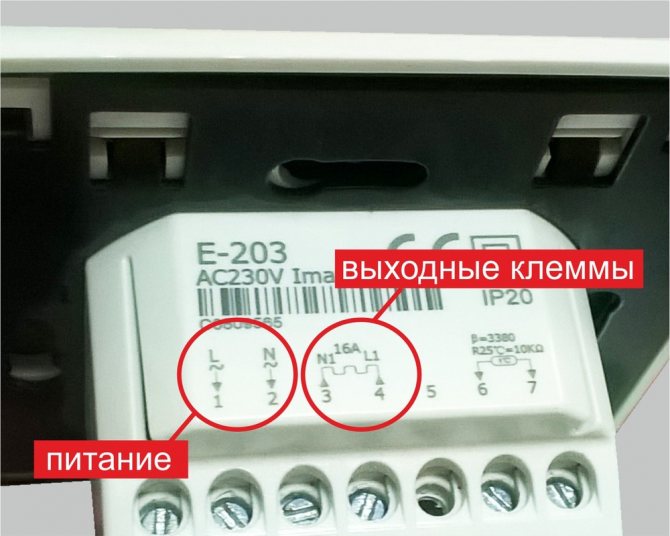

There is no voltage at the thermostat. It is checked with a multimeter or an indicator screwdriver on 1 and 2 terminals of the thermostat.
Thermostat malfunction. It is checked by measuring the voltage at the output terminals (usually 3 and 4 terminals) of the thermostat. When the thermostat is on and the command is given to turn on the heating (forms the thermostat), a voltage of 220-230V should be present at these terminals. If this is the case, then the thermostat is working, if not, then it must be replaced.
Malfunction of the supply wire going from the thermostat to the film floor (breakage, squeezing, burning, etc.). It is checked by measuring the resistance between the supply wires of the warm floor with the thermostat turned off. A high resistance indicates an open wire. It needs to be examined.
Where do the leaks in the heating system come from?
The most common cause of leaks in metal pipes is corrosion. Steel, even treated with special coatings, rusts. Only the speed of the process differs. It depends on the operating conditions of each specific system.
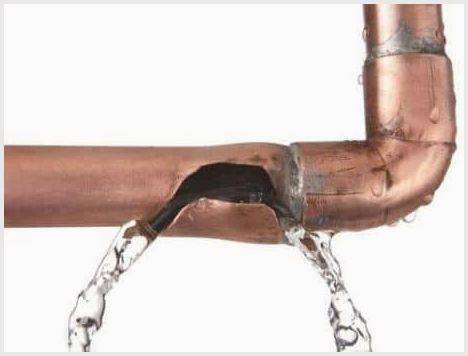

The metal is affected by temperature extremes, moisture, hydraulic shocks. Impurities in the coolant can contain aggressive chemicals, abrasives that accelerate corrosion. The places where the elements of the system rust the fastest begin to leak. As a rule, these are connections, joints, seams.
Polymer materials do not rust, but this does not mean that they do not leak. Sooner or later, metal-plastic pipes may also leak. Most often, this happens if they are incorrectly selected. Some homeowners save money and buy cold water pipes. This is a big mistake, because leads to deformations, breaks in the system.
Often homeowners suffer when they choose low-quality products for heating. Cheap polymer pipes swell, burst, and flow. If this happens, you have to change the damaged sections. Imaginary savings turn into additional costs of money, effort and nerves.
The least susceptible to the risk of leaks are metal-plastic pipes, which are specially designed for heating systems. They are designed for a high coolant temperature, do not deform and can last for several decades.
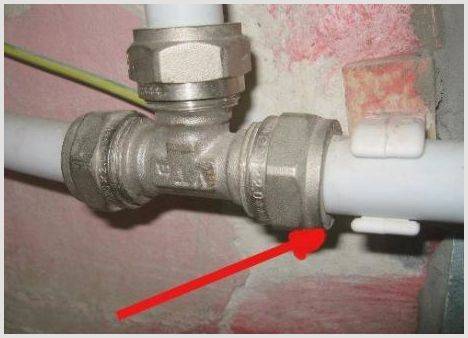

How do I find the problem?
If there are signs of violation of the integrity of the circuit, you can find the problem area and eliminate the leak without opening the entire coating.
In practice, the following methods are used:
- Place a plastic wrap over the screed and leave it overnight. Abundant condensation forms in the damaged area of the tubes.
- Instrumental way. To do this, pressurize the system and listen to the screed surface with a stethoscope.
- Thermal imaging survey. Allows you to accurately determine the layout of the pipes and the place of leakage. The device registers the minimum temperature deviation on the surface, the wet area on its display looks like a blurred red spot. High-precision diagnostics is carried out provided that the thickness of the cement screed does not exceed 12 cm, and glossy ceramic tiles with high reflectivity are not laid on top.
How to find water leaks underground or in a screed
If pipes have flowed underground, in walls or in the underfloor heating circuit, it is very difficult to do without the help of specialists. To detect such breakthroughs, devices are used:
Thermal imagers. The temperature of the surface under which the heating system is hidden is high enough to use the thermal imager. If the pipes are shallow, then this device will be the easiest way to find a leak. Problems can arise only in the case of a large depth of pipes or a low temperature of the coolant.
Moisture meters. This is a less effective way to find leaks than with thermal imagers, but a moisture meter can still be useful in detecting leaking pipes in walls or in warm floors. It is not used to search for underground utilities.
Acoustic devices. Sometimes a leak can be detected using a special device that picks up sounds. By its construction, it resembles a phonendoscope. However, the benefits from it are far from always.


System "Neptune" - instant detection of leaks
There are special systems that instantly determine the locations of leaks in heating and water supply systems. Their installation will have to spend time and money, but the costs pay off with interest: thanks to such devices, problems can be avoided in case of serious accidents. The most popular is the domestic system "Neptune". It is cheaper than imported counterparts and has proven itself well.
"Neptune" not only instantly finds a leak, but also blocks the water supply. The system consists of a control unit, sensors and valves. It is fully automated, and once installed, the owner of the premises will no longer have to worry about breakouts. As soon as the sensor sends a signal of a leak to the main unit, the valves are activated and shut off the water. Further, the owner can deal with the solution of the problem, without thinking that he will flood his neighbors or his own house.


How to find a leak in the underfloor heating circuit yourself
Floor leaks can be a real problem. If the cover can be easily removed, it makes it very easy to solve. Difficulties arise if the contour is located under the screed. Occasionally the breakout point will reveal a damp spot on the floor, but this only happens in cases of serious damage. When the pipe just leaks a little, it's harder to find the problem. Let's consider how to act in such a situation.
You can try to find the leak yourself, but first you have to determine where the pipes are generally located. To do this, turn on the warm floor for maximum heating, and the screed above it is abundantly moistened with water. Moisture evaporates the fastest above the loops. This will show in the lighter and drier areas of the floor.
The brightened areas are outlined with a pencil, at the same time keeping track of how fast they dry out. Where the wet spot remains the longest, look for a pipe break. This method does not always work 100%. It always shows the location of the pipes, but the faulty section is visible if the leak is strong. To find and eliminate the leak, you will have to break the screed over the warm floor.
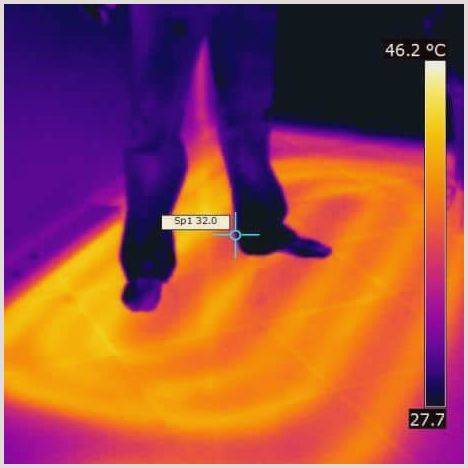

Leaking water floor. Leakage signs, consequences, repair
What are the signs of a warm floor leak? It happens that it is impossible to make a mistake - while working, they pierced the pipe with a sharp tool, a wet spot appeared, this is already an SOS signal. The pressure in the pipeline has dropped, and if a failure in the equipment is excluded, then it is necessary to urgently diagnose the floor at the time of the leak. Even minor damage can not only reduce the efficiency of the system, but also trigger the destruction of the entire floor. The place of leakage is determined visually - by wet spots on the floor, using a thermal imager or moisture indicator.
Before starting repair work, shut off the flow of water into the pipeline, provide access to the pipe by opening a small section of the floor. After removing the damaged section of the pipe, it is necessary to protect the pipeline from dirt entering the system by isolating the resulting ends with improvised means (rubber glove, plastic bag). When replacing the damaged area, it is not recommended to use threaded fittings, the connections should be crimped. After repair, the joints are tested under pressure. That's it - the floor can be closed in the reverse order.
Leakage to be done immediately
What to do immediately after detecting a leak in the heating system depends on two factors: the type of dwelling and the type of the leak itself. If the heating is leaking in a private house, then the owner can repair even a serious breakdown himself. But in the apartment you have to act more accurately and quickly. First, you can flood your neighbors from below. Secondly, you have to turn off the heating riser, which means that all apartments will cool down.
If the leak is small (the pipe or radiator only gets a little wet), you can try to eliminate it yourself with the help of improvised means.If it flows strongly, then it is necessary to immediately shut off the coolant supply and call the emergency team. Until the heating is turned off, you need to throw a blanket over the radiator or pipe so that no one gets burned from hot water.
In some apartments, special valves or taps are installed, with which you can shut off the coolant supply. However, most often such cranes are installed on the entire staircase and located in basements. It is necessary to go down there and block the riser on the main pipe. After that, you should immediately deal with the elimination of the leak.
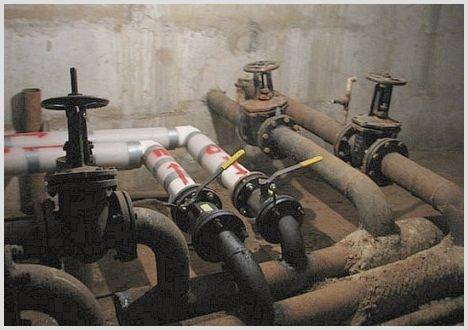

What to do if an electric warm floor has broken through?
It so happens that when installing a film structure, pouring concrete or installing tiles, you can break through the wires of the warm floor. Of course, it is impossible to notice this immediately, but the breakdown will manifest itself when the system is turned on. Then it will be noticeable that the film warm floor does not heat. The first step is to determine exactly where the breakdown occurred. If it was possible to determine that the heating cable was broken, then it is worth finding the place of breakdown. Removing linoleum or laminate flooring will not be a problem. It will be much more difficult to dismantle the tiles. After opening the topcoat, as a rule, no breakdown will be visible. Next, you need to cut the cable. This will create a ringing area. Having determined the breakdown, you need to connect all the cuts and breakdowns with couplings.
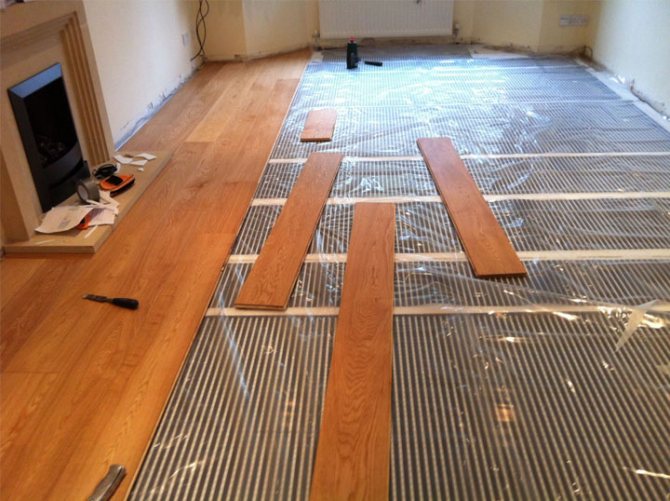

An alternative would be to use soldering and heat shrink tubing. Having covered all the places of interference with electrical tape, it is worth sealing the emergency place.
The ingress of moisture into the system is critical. If the system is installed in a shower, a moisture barrier must be used.
All malfunctions of the electric underfloor heating can be repaired by yourself. It is only important to determine where the breakdown occurred.
Causes of leaks
Among the reasons why a coolant leak occurs (any, and not only water), there are three main ones:
1 Corrosion; 2 Violations in the technology of installation of the system; 3 Illiterate exploitation.
Corrosion of a metal is caused by two types of chemical reactions: oxidation under the influence of oxygen and an electrochemical reaction that occurs when metals dock with different numbers of negative and positive ions in the atomic structure of a substance.
Technological irregularities during the installation of the system, which lead to leakage of the coolant, include, for example, the use of inappropriate electrodes and the occurrence of local foci of electrochemical corrosion in the places of welding seams. The most sensitive to violations in the installation technology are metal-plastic pipes connected by threaded fittings. Such a leak is practically unavoidable and requires a complete replacement of the pipeline section together with the fitting.
Incorrect work and selection of materials
The illiterate operation of the heating system also leads to water leaks from the pipes. For example, boiling of the coolant and the accompanying hydrodynamic shock lead to damage to the gaskets and even destruction of threaded connections. If it is decided to change the type of coolant by replacing the water with antifreeze, then you need to be prepared for the threaded connections to flow. This is especially true for those devices that were mounted twenty years ago and were used to seal them with tow, oil paint, rubber and other inexpensive auxiliary materials.
An unnecessarily high pressure in the system also leads to water leakage from the pipes. It does not affect the efficiency of its work in any way and even harms, leading to boiling of water at temperatures below 100 ° C. Pressure is needed to pump the coolant to the upper tiers of multi-storey buildings or to activate sluggish thermal convection in single-pipe systems with lower wiring. In one-story houses, it is better to use circulation pumps with a working pressure of no more than 1.5 atmospheres.
Reinforced-plastic pipes, which have become popular recently, are very sensitive to the operating mode. They cannot withstand sudden temperature changes, overheating and water hammer. Their structure delaminates, as a result of which the pipes lose strength, cracks and fistulas appear in them.
Reasons due to which damage to the warm floor may occur
Underfloor heating, in terms of its reliability and operational parameters, is one of the most reliable, practical and durable heating systems. The design features allow not only independently, with your own hands, to lay a warm floor in your house, but also allow you to eliminate technical problems on your own. From a technological point of view, any underfloor heating system justifies the investment and effort, but even the most reliable equipment can fail, and at the wrong time.
For reference: functionally, a properly laid warm floor can effectively do its job for a long time. According to the technology, the water floor works normally for 25-30 years, if all operating parameters are observed.
If the problem with a warm water floor is not critical, you can try to fix the technical failures yourself. However, in order to do everything right this time, you need to have an idea of how the water floor works in your house. The main reasons why a coolant leak can be found in a warm floor are commonplace. This is usually our negligence. In most cases, damage to the water circuit occurs during construction work.
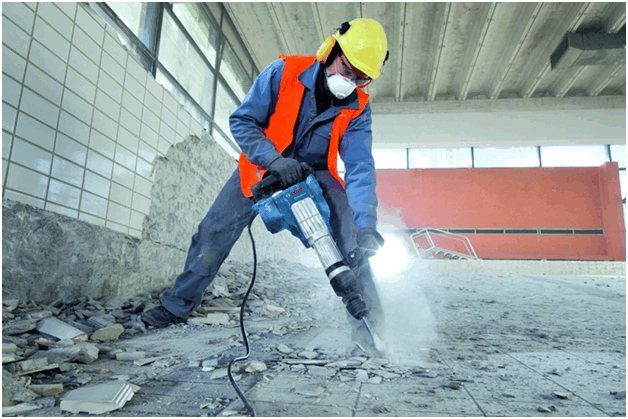

Working with heavy mechanical tools, for example, a hammer drill, it is very easy to cause mechanical damage to a pipeline embedded in a concrete screed. If you do not know how the pipe was laid in the floor, then in this situation the probability of damaging the integrity of the water circuit is almost 100%.
During installation, careless behavior of workers can lead to the fact that the pipe will receive mechanical damage even before it is laid. The usual accidental blow with a hammer, a drop in gravity will cause microcracks to appear on the pipe walls.
For reference: similar troubles often arise in an apartment with electrical wiring, installing suspended ceilings, installing or dismantling interior partitions. The absence of a technological scheme leads to unauthorized damage to the electrical cable. The situation is similar with underfloor heating, both with water and with an electric cable.
Another reason why a break can occur is a defective pipe of the water circuit. In most cases, this is due to the use of consumables of unknown origin during the installation process. The inconsistency of the pipe material with the technological parameters in which the warm floor is used often leads to a violation of the integrity of the pipeline.


For example: a pipe from an unknown manufacturer, with a missing certificate, may have a non-uniform wall thickness. With an increase in the temperature of the coolant and the working pressure in the system, weak points in the pipeline can become a place of rupture.
In this aspect, it should be recalled that an unprofessional installation of a heating system often causes a leak. Poorly made connections become, in 50% of cases, the cause of a violation of the integrity of the water circuit.
On a note: professionals recommend using solid pieces of pipe when laying the underfloor heating pipeline, trying to do so that all fittings and joints are brought out.
It is almost impossible to detect the extent of damage by eye. At first glance, the pipe may appear to be intact, the joints are strong and reliable in appearance.Starting the heating system, the pressure rises in the pipeline (1.5-2 bar), which naturally forces the liquid to look for a way out in the weak points of the water circuit.
The last mistake that can cause a violation of the integrity of the pipe is an improperly laid screed.
At first glance, there are many reasons why a warm floor can be damaged. Don't panic. In this situation, the main thing is to choose the correct course of action and start eliminating the accident.
How to find a water leak in a heating system
If the supply or return lines from pipes of classic traditional heating or heating devices of heat exchangers (batteries) have leaked, then it is not difficult to immediately find a water leak in the heating system and identify the place of the leak. External visual control will help you do this quickly. It is much more difficult to do this in a heating system in the form of underfloor heating or heated walls.
- Moderate prices with good quality
- Departure on the same day
- We work all over Russia
- Full working cycle from search and location of the leak to the "turnkey" restoration construction works
- Application of new technologies and equipment
- Professional skills for over 10 years
A powerful trickle of hot heat carrier that gushes out of the floor will bring quite a lot of trouble, but it is easy and quick to identify it. Much more unpleasant is a small leak in a wall or in a heated floor, covered with a concrete screed. If under the screed there is a good protection against the negative effects of moisture in the form of a "trough", then until it is filled with water, you will not know about it. "Man-made lake" with warm water in your floor will eventually overflow. The water will find the gap and start flowing out a little. As a result, the ceiling or wall under the heated floor on the lower floor will lock up, and this process will not stop until mold appears and the gradual destruction of building structures from the corrosive action of water, enhanced by heat.
There is a way to find the presence of a leak in a heating system with underfloor heating. In most cases, a device for determining the value of pressure, measuring pressure, is installed on a boiler for heating in such a system. And if, when the floor or wall heats up, the pressure drops according to the readings of the device for determining the pressure value, then a small leak is found.
Attention! Important! If the expansion tank of the heating system is not sealed, then the pressure can drop through it. It can also fall through the air vents, i.e.
automated cranes Mayevsky
e. automated cranes Mayevsky.
It is necessary to check all open parts of the pipelines and joints. But with rather hot water, a puddle of water that seeped at the junction and appeared on the floor can quickly evaporate, and you will not notice the result.
Instruments for finding leaks in floors and walls
There are a few of these devices:
- Thermal imager. Fixes a temperature rise of a couple of degrees. But:
- the water may be slightly warm;
- the leak can be hidden by a thick concrete layer;
- the place may be inaccessible to the device.
- Surface moisture meter - allows you to measure the increased humidity of the wall plane.
The method gives low accuracy, requires a lot of time. It is better to duplicate it with a thermal imager showing a large problematic area, and then look for it with a moisture meter.
A sound device, similar to a hospital phonendoscope. Allows you to hear the sounds of the "trickle" flowing in the wall and find the leak.
Our company can remove almost all the problems associated with leaks in heating systems, both in a private house and in Moscow companies.
We are engaged in the provision of the following types of services:
- search for leaks and localize these places;
- we find the location of the hidden pipelines of the water metering unit and heat supply;
- we check the condition of pipelines;
- we examine the premises and find places of heat loss using a thermal imager;
- we localize and completely eliminate leaks in pipes with hot and cold water;
- we can find places of violation of thermal insulation, and much more.
In case of problems, call our professionals at any time. Departure of professionals in Moscow is free and fast on the day of contact.
Cable underfloor heating does not heat well: the main reasons
Before making sudden decisions about faulty operation, you need to objectively assess the operation of the system. To do this, you need to follow 2 simple steps:
- Start heating for 30–90 minutes. The warm-up time directly depends on the quality of the insulation and the thickness of the topcoat.
- Wait until the temperature regime matches the temperature set on the sensor. After proper heating of the working surface, the device will turn off and the indicator will stop glowing.
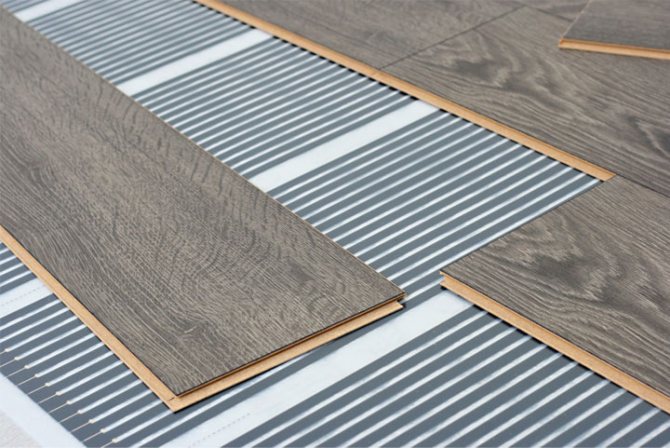

Repair of warm electric floors will be necessary only when the heating time is much longer than the normalized one, and the light on the thermostat does not turn off. It's time to find out why the warm electric floor does not work. This may be due to the following factors:
- Incorrect selection of heating wires. The type and power characteristics of the cable are selected based on the technical conditions for working with the floor. With self-design, there is always the risk of making incorrect calculations. Only qualified specialists will help to correct such shortcomings. Therefore, during installation and development, you need to be extremely careful.
- Installation inaccuracies. The installer may not be able to calculate all the nuances of working with the structure, especially if he is inexperienced. The performance of the system depends on the correct installation of the temperature sensor. If it is installed incorrectly, then you can never wait for the system to completely heat up. Accordingly, a cold winter awaits the owner of the house.
- Damage to the wiring. If screed or tiling was done, then there is a possibility that the cable was damaged.


- Damage to the temperature sensor. You need to check the connections. The terminals must be in a tightly tightened position. It is also worth checking the voltage at the terminals of the wires. The value should be the same as when the temperature sensor is on. In addition, it is necessary to measure the resistance of the device.

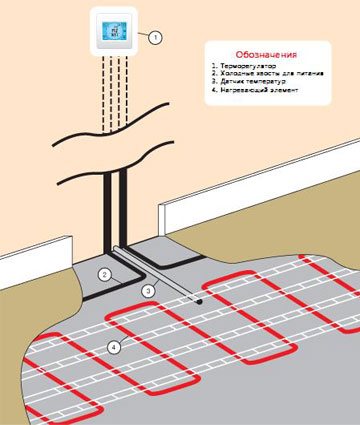
Temperature sensor breakage - Low voltage. Electric underfloor heating can be repaired due to improper power supply. Low voltage significantly reduces the capacity of the entire heating system. You can solve the issue by installing a stabilizer. This will provide the proper power density level by increasing the voltage.
The greater the voltage drop, the lower the floor power!
- Lack of thermal insulation, incorrectly selected material thickness. The deficiency is especially noticeable on the first floors. The thinner the insulation layer, the greater the value of heat loss. Often, users complain that the electric underfloor heating does not heat up, looking for the causes of the malfunction. But the point is not in the heating system itself, but in the incorrect calculations of thermal insulation. If the underfloor heating has already been installed and there is no way to increase its efficiency, then it is worth reducing heat loss by installing additional insulating materials.
Eliminating a leak in the heating system with your own hands
If the leak is strong, shut off the heating supply in the riser. In the event of a minor malfunction (if water barely drips), you can immediately start to eliminate it. Consider how best to fix the heating system.
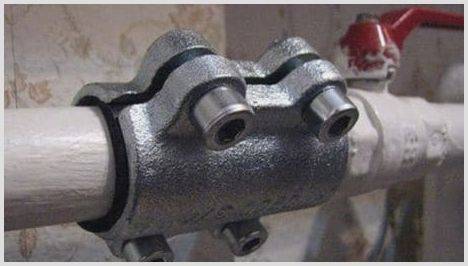

Option # 1: when the pipe is leaking
If a section of a steel pipe has leaked without a thread, then the problem is a poor-quality weld. A clamp is required to repair the damage. You can buy it at a hardware store or make it yourself from a metal strip.A gasket or a piece of a bicycle tube is used as a seal.
The pipe is cleaned of paint overflows, a dense rubber gasket is applied on top, then a clamp. Bolts are provided for fastening the clamp. They are tightened as tightly as possible. Sometimes the damage is additionally treated with a sealant. This is a great way to tightly close a hole in a pipe. There will be no more leaks.
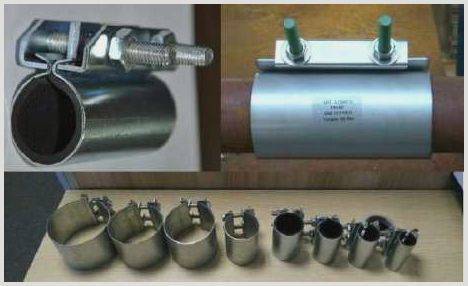

Option # 2: Leaking under the locknut
If the locknut is initially secured correctly, leaks can result from mechanical damage or corrosion. It is necessary to shut off the riser and dump the water. After that, the nut is unscrewed, sealed with flax, paint or a special compound and tightened again. Plumbing linen and other seals are wound clockwise.
When the work is finished, you need to open the riser valve again and check the tightness of the connection. If water still seeps out, repeat the procedure by adding 5-6 new threads on the pipe.
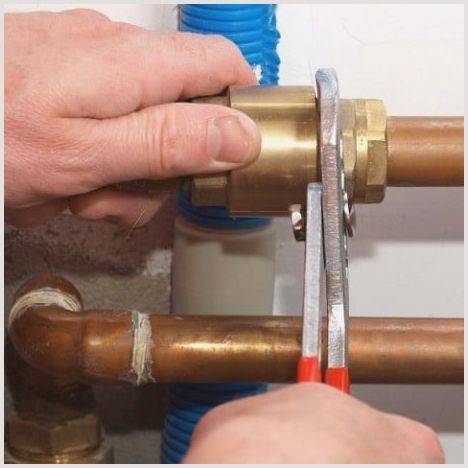

Option # 3: if the radiator is dripping
The radiator plate or the joint between the sections can leak. In the first case, it is better to immediately replace the damaged element. If this is not possible, then a small leak is dealt with using cold welding. You can buy it at any hardware store. Instructions for use should be on the packaging.
To repair the radiator, block the riser, clean it, degrease the damaged area, after which a sealing compound is applied to the hole itself and the area around it. Welding should close approximately 3-4 cm of pipe around the fistula. The composition quickly solidifies. After complete drying, you can start heating.
If it flows between the sections, then the radiator is dismantled and the nipple connection is tightly tightened. When fixing the nipple, you need to make every effort. It is almost impossible to break it, so you should not be afraid. At the end of the work, the radiator is installed in the old place and the coolant supply is turned on.
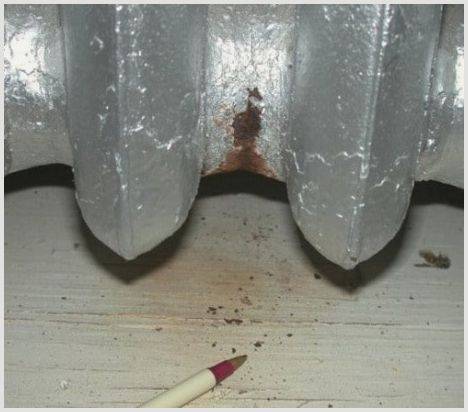

Underfloor heating repair
So, diagnostics showed a break in the heating cable Your warm floor. The "diagnosis" is certainly not fatal, but rather unpleasant. Definitely, you will have to open the tile, pay decent money to the master for finding the exact place of the break and repair, and then worry about restoring the tile. That is, the question "what to do?" more or less clear. There remains one more, no less burning - "who is to blame?"
In order to figure out who is to blame, you need to determine the cause of the break. This is found out with great accuracy when opening the tile at the place of the cliff.
Let's consider the main reasons for the breakage of the underfloor heating cable.
- Causes of floor heating malfunctions, can be conditionally divided into three groups:
- Group 1 - mechanical damage that occurred after laying the warm floor. It is to this group of reasons that this article will be devoted.
- Group 2 - cable damage when laying tiles - the topic of the next article.
- Group 3 - violation of technologies for the device and repair of a warm floor, the final article will tell about it.
In this article, we will look at the first group of reasons for the malfunction of the warm floor - these are examples of mechanical damage, in other words - breaks of the heating core that have occurred after laying or during the operation of the warm floor.
Breaking the cable with a dowel.


Underfloor heating cable accurately punched with a dowel when installing the door stop
Quite a common reason. Occurs during the execution of finishing or construction work on the floor in the area where the cable is located. The classic option is to install a door stop. Also a common option is to install plumbing fixtures, such as a toilet bowl or washbasin “legs”.
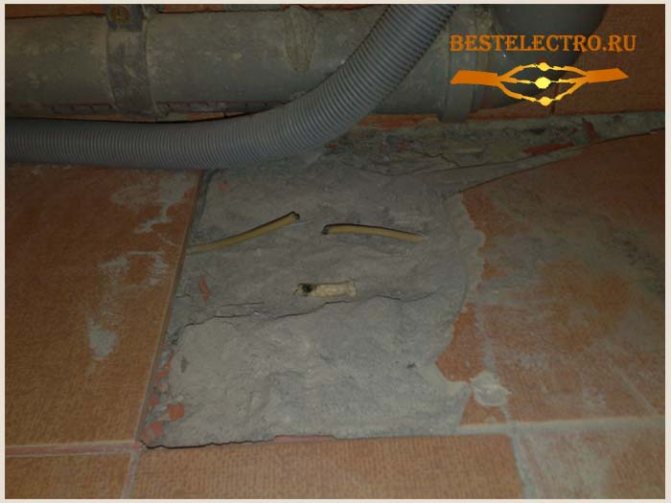

Breakage of the cable when installing the "leg" of the sink
Another similar thing happens when installing plasterboard partitions and decorative boxes, when the guide profile is attached to the floor with dowels.
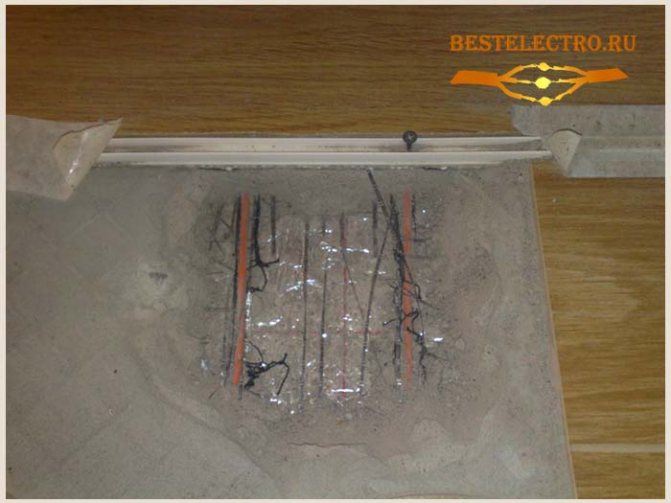

The underfloor heating cable is pierced with a dowel when installing the partition
Fastening the door sill can also damage the cable, especially when laying the same cable in adjacent rooms.
A separate type of dowel penetration is the installation of fences and railings on a heated porch or veranda, most often in a country house.
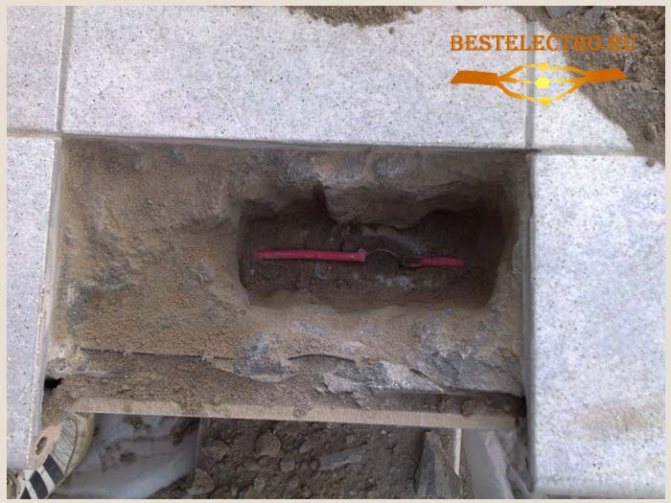

Mechanical damage when installing fence elements on the porch
The image clearly shows that even the deep laying of the cable on the porch did not save from damage.
To summarize the above: in rating of the causes of malfunction of the warm floor by a large margin, the leading is the damage to the cable by the dowel when working on an already mounted or working underfloor heating.
Damage to the cable by the grinder.
If it is necessary to dismantle one or more tiles, in order to preserve the neighboring ones, sometimes the seams are cut with a grinder.
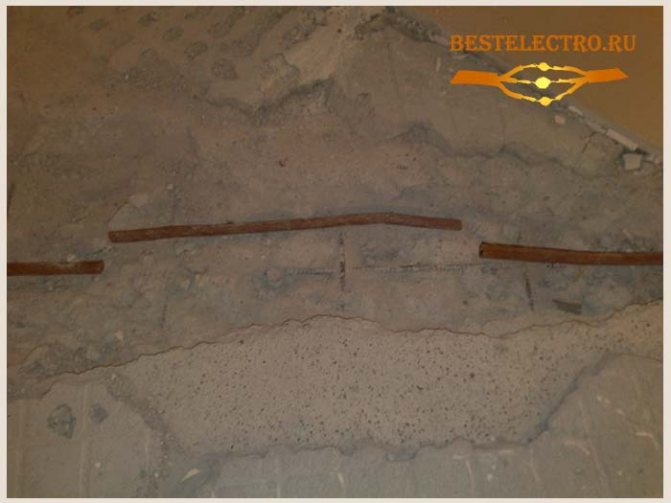

Damage to the underfloor heating cable by a grinder when dismantling a tile
If the underfloor heating cable is not located deeply under the tile, in most cases it is damaged, because it is almost impossible to accurately control the cutting depth and the grinder's disc deepens deeper than you planned.
Sometimes, when joining seams, when work is done with a delay and the solution has already hardened, a grinder is used. Of course, this is not correct and the result of such work is predictable - a cable break, and, as a result, a malfunction of the warm floor.
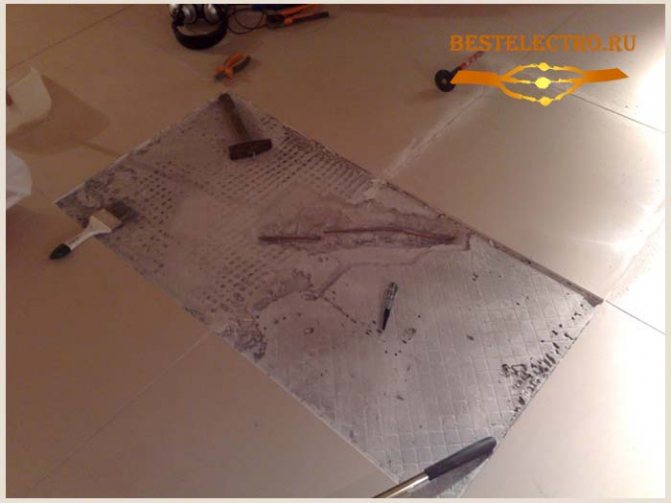

Mechanical damage to the cable during the "jointing" of the seams with a grinder.
Also, damage to the heating cable is possible when dismantling the tile with a hammer drill.
As you can see, it is also very common the reason for the malfunction of the warm floor... In our rating, she is in second position.
Damage to the cable by other construction tools.
Cable damage can occur when drilling holes, trimming / leveling the edges of the coating, especially from natural stone.
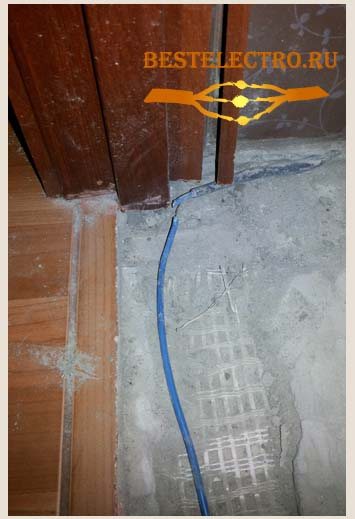

Underfloor heating cable damaged under the door
Similar damage occurs when installing doors (as seen in the picture), laying communications, expanding openings.
So, this article gives examples of malfunctioning underfloor heatingalready arisen after installation or during operation, which were caused by mechanical damage with a dowel, grinder, hammer drill and other tools.
The master will help to establish the exact cause of damage to the cable, he will also repair the cable of the warm electric floor and give a guarantee for the work performed. Call.
What areas and elements can leak
The most common leak is in metal pipes. The elements that can be destroyed are as follows:
- joints of pipes, adapters and seams;
- one-piece pipe;
- radiator;
- under the lock nut;
- in the underfloor heating circuit;
- space between battery sections.
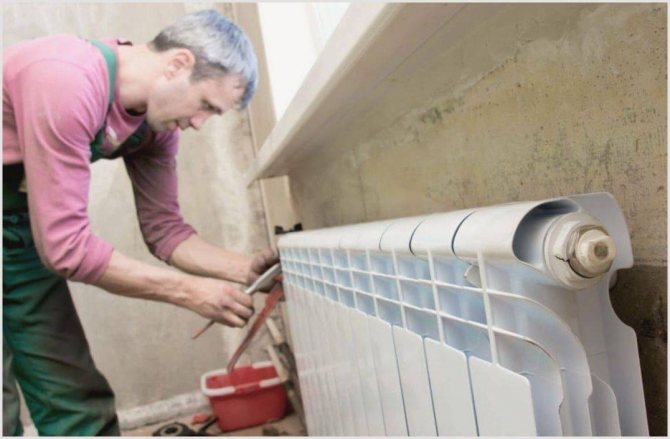

Heating system leaks are often found in radiators
Most often, cheap polymer pipes are subject to violation of integrity. They break, flow, swell. Reinforced-plastic pipes are also susceptible to leaks if they were incorrectly selected. There are special products for the heating system. If pipes for cold water are installed in it, then under the influence of high temperatures they are deformed and burst.
Causes of leaks in a warm floor
There are many reasons that can lead to underfloor heating leaks. One of the most common defects in the production of pipes and fittings. Inexpensive products sometimes have different wall thicknesses, which can lead to rupture with increasing temperature and pressure. The second most common is a poor-quality pipe connection.Experienced installers always advise not to save money and lay a continuous line of underfloor heating, since the fewer the connections, the less likely it is to run into a leak in the future. The third reason may be the mistakes of the builders working in the room after the pipes have been laid. Any unsuccessful step or dropped instrument can lead to microcracks and deformations invisible to the eye, which may later lead to the formation of a fistula.
What elements can leak
There are several ways to eliminate leaks. The selection of the correct methods depends on the type of system element in which the leak occurs. This could be:
One-piece pipe. Here, the holes are tightened with clamps, self-tapping screws, sealed with special compounds or cemented. If the pipe is plastic, it is best to replace the entire length. If this is not possible, use artisanal welding.
Places of connections. There are many different connections in the heating system - pipe attachment points, adapters, etc. Leaks appear either due to loose fasteners, or due to corrosion. Polymer parts are easier to fix, but with steel and cast iron it is more difficult: you have to apply force or use cold welding.
Between battery sections. The reason is the same - leakage. Sometimes it leaks due to mechanical damage. If water seeps between sections, remove the radiator and tighten the connections.
On the radiator plate. In this case, it is advisable to immediately change the radiator, because the most common cause of breakdowns is thin walls and low-quality material from which the heater is made. If it is not possible to replace it immediately, then cold welding will save, but this is only a temporary measure. In the next season, new troubles may arise.
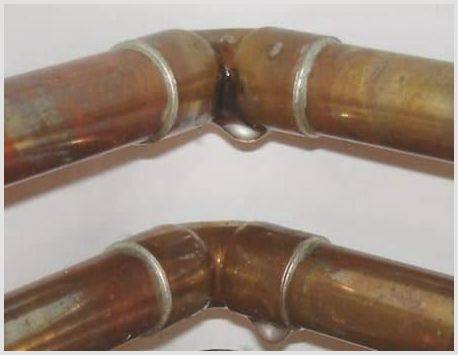

Why are leaks occurring?
With the correct installation technology, the use of high-quality materials and the observance of the operating rules, the water floor can last up to 30 years.
The main reasons for the leakage of the coolant are as follows:
- improper installation - in 50% of cases, breakdowns occur due to leaking connections;
- low-quality materials - tubes may have unequal wall thicknesses; with increasing pressure, a crack may appear in thin sections;
- laying the circuit from pieces of pipe - it is recommended to make it from a solid material with the connection outward;
- mechanical damage during laying or repairing the floor covering.
Leakage reasons
It is important not only to detect a coolant leak in the heating system, but also to understand for what reasons it has arisen. The situations in which the monometer on the boiler can show low pressure are as follows:
- violation of the tightness of the joints as a result of corrosion of pipes, wear of gaskets or loosening of threaded connections;
- thermal expansion and contraction of fittings. When the coolant reaches a certain temperature, the metal parts expand, but as soon as the water cools down, the metal of the fittings narrows and begins to let the liquid through;
- change of the coolant in the pipes. If you first used water, and then decided to pour antifreeze into the system, the seals may expand, then dry out;
- overpressure in the heating system due to too small expansion vessel. This can lead to cracks in the pipes.
In addition, leakage occurs as a result of improper installation or operation. This is especially true for metal-plastic highways, which are more sensitive to any violations of the installation technology.
How to repair a water-heated floor with your own hands
A warm water floor, like everything made by human hands, is dismantled or repaired. We will tell you about its maintainability.
After installation, the underfloor heating system is pressurized and filled with coolant. The pressure during pressure testing is usually equal to two times the working pressure (4-6 kg / cm 2).Working pressure 1-2 kg / sq. Cm. Here it must be borne in mind that in cottages and city apartments with installed gas or liquid boilers, the recommended pressure in the entire system is 1.5 - 2.5 kg / cm 2. As for city apartments with centralized heating, the water underfloor heating is connected only through a heat exchanger and in the internal water circuit of the underfloor heating, more than 1 kg / sq.cm pressure is not set, and the time for pressing with a higher pressure, such a system, no more than 4 days ...
After crimping the water-heated floor system, a concrete screed is mounted, time is given for the screed to set, and the heating is turned on. The next stage is the flooring of the final floor covering, we will dwell on it in more detail.
Of the existing flooring, linoleum practically does not fit when using warm water floors. Remains tile, laminate, parquet and parquet board.
Parquet and parquet board, as well, are not practiced for underfloor heating, because they have low thermal conductivity and there is a possibility that they will dry out.
Remains Tile And Laminate. The ideal flooring for a warm water floor is tiles, and many people even install tiles in bedrooms. Laminate is based on paper impregnated with resins, it also conducts heat well despite the shock-absorbing backing.
So, you already have a clean flooring installed and heating turned on. Everything works, warm and comfortable.
From my own eight-year experience, I can say: If you have all water circuits of a warm floor without connecting fittings in concrete, then the pipe itself, even after 10 years of operation, will never flow!
There are two reasons for the leak: man-made and human factors.
The first reason excludes repairs due to its complete meaninglessness.
Let us dwell on the second in more detail. You can pierce the water contour of the warm floor: with a crowbar, a drill bit or a hammer drill. In this case, about a liter of coolant is poured out (in the event that the system is connected correctly, and not directly to the central heating main, for example).
If a hot water floor is connected to a heating boiler, then it is necessary to turn off the taps on the collectors, because the boiler can be connected to the mains and in case of pressure drop it can be recharged automatically.
So, if you have punched the water circuit of the warm floor, you need to free this place from the finished floor covering, then gently beat off the concrete in the place of damage with a puncher or chisel by hand. Keep in mind that adjacent pipes are 15-22 cm apart. If you accidentally hit the pipe with a chisel, then most likely nothing will happen from one blow to the pipe.
So, you have freed the pipe from the concrete at the point of damage. Cut the pipe in the place of damage, carefully cut the edges of the pipe so that they are straight and not deformed. Keep in mind that the total length of the cut pipe segment should not exceed 7-8 mm, otherwise you will have to install 2 fittings.
Connect the cut pipe with a fitting and prime the system, bleed air, and set the maximum pressure allowed for the connection. Once you are satisfied that everything is working and there is no leakage, set the normal working pressure.
It is necessary to cover the entire fitting with silicone and wrap it with polyethylene, this is done so that the aggressive alkaline medium of liquid concrete does not begin to corrode the metal of the fitting. If the fitting is polymeric, then the above procedure can be omitted.
Then we just have to fill everything with concrete to the previous level, wait for the concrete to set, dry, and only then can we lay the final floor covering.
In conclusion, we can say that with proper operation, a water-heated floor will last at least 40 years. But even if you damaged it, you can always repair it locally.
Search and elimination of coolant leaks
Finding a place where water leaks through puddles on the floor is easy. But if you inadvertently brought the matter to this, then you can consider yourself on the verge of a communal catastrophe of a local nature.
Therefore, you need to pay attention to the details - the appearance of rusty streaks in the places of threaded connections, swelling on the surface of metal-plastic pipes, their loss of shape and strength. If the heating pipes are laid in the thickness of the walls or a "warm floor" system in a concrete screed is arranged on a separate circuit, then leaks can be found only with the help of special devices
A weak (drip) leak can be eliminated without draining the water or stopping the heating of the house. Elimination of flows of different intensities is possible only on dry and cooled pipes. Therefore, it will be useful to arrange bypass lines (bypasses), dividing the system into several circuits and independent sections using installed ball valves.
Repair of metal pipes and their connections
Even heavily corroded metal pipes have a high residual strength, therefore, during repairs, significant pressing forces can be applied to them and clamps tightened with bolts can be used. For their urgent repair, you may need:
- Heat resistant (red) silicone sealant;
- Rubber elastic bandage (sold in pharmacies);
- Two-component metal-filled epoxies (cold welded);
- Bolted metal clamps;
- Thin fiberglass or old women's tights.
In case of a slight leak in the threaded connections, it is enough to unscrew the lock nut (if any) by a quarter of a turn to form a gap of 0.5 mm. Silicone sealant is squeezed into it and evenly distributed over the entire circumference. After 30 seconds, when the sealant begins to polymerize, the nut is tightened.
If there is no lock nut, then it is necessary to clean the joint from old paint, scale, rust and degrease it. In case of a weak leak, you need to break a piece of "cold welding", as described in the instructions for it, and evenly distribute it around the entire circumference of the joint, especially carefully smearing the edges of the joints. For a higher flow, you can apply a silicone sealant or a two-component metal-filled compound to the joint and press it with a tape of fiberglass or a piece of women's tights.
A crack or fistula in the pipe can be wrapped with a rubber elastic bandage, overlapping with each subsequent turn half of the previous one. The length of the winding should be twice as long as the damaged section. It is necessary to make 2-3 layers of winding and secure it with clamps. A good result is obtained by winding with a hemostatic tourniquet from a car first-aid kit, which can be secured with a standard latch. A crack in a pipe can also be repaired with an epoxy compound in combination with a reinforcing material - elastane or fiberglass. But at the same time, you will have to clean up to metal and degrease the entire area on which the bandage will be applied.
Easy ways to find the problem
Craftsmen suggest using a liquid designed for car glass care. The presence of dyes in its composition makes it easier to find a problem area - it will be visible on the floor surface. After pouring it into the system, the circuit is subjected to air injection; under pressure, the liquid is gradually displaced from the pipes. The dyed mixture will quickly fall into the vulnerable area and, due to the impact, will tend to seep out.
The second method is to supply air to the freed pipeline, and the circuits should be processed in turn. At points where there are defects, the air stream will actively escape outward, thereby indicating the presence of a leak.
When the contour is hidden under the screed, a damp spot on the floor signals the place of a breakthrough only in case of serious damage that threatens to flood the neighbors from below. And if the pipes are leaking only slightly, it is much more difficult to find the weak connection yourself.
If the communication schemes located under the concrete are not available, the first step will be to determine the principle of placing the branches, their exact location. To this end, it is necessary to start the underfloor heating system, moreover, it is desirable to activate the maximum heating, while the concrete screed must be wetted abundantly. Next, you need to carefully observe where the liquid disappears most quickly: it evaporates most strongly directly above the loops of the circuit. Dryer and lighter areas of the coating will gradually appear.
As you find these zones, you need to circle them with a pencil, moreover, you need to monitor the speed of their drying. Most likely a pipe break is where the wet spot does not come off for a longer time. This method does not give a 100% guarantee of leak detection, because only an intense loss of coolant will appear. But its obvious advantage is the ability to draw up a pipe layout.
Repair of underfloor heating, in the event of a leak
Damage to a metal-plastic pipe underfloor heating with a perforator or grinder is the most common problem, primarily involving keeping calm. If there is a leak of a warm floor, it is necessary to shut off the water without removing the tool that damaged the pipe. Then it is necessary to clear the access to the damaged area and remove the damaged section of the pipe by cutting it on both sides. If you do not have the required length of identical pipe and fittings at hand, you need to put plastic bags on the free ends to prevent dirt from entering the system.


Crimp wrench and fittings for underfloor heating repair
After you have purchased the necessary parts, the only possible option for repairing a warm floor is pressure testing. To do this, you will need a press, which you can rent. It is worth remembering that it is highly undesirable to use threaded fittings, since sooner or later they will still leak. If you have a warm floor drip, do not panic, because this is not the most difficult problem that can occur with water heated floors. Let's take a look at some more problems that can occur during the operation of warm water floors.
Manometer reading changes
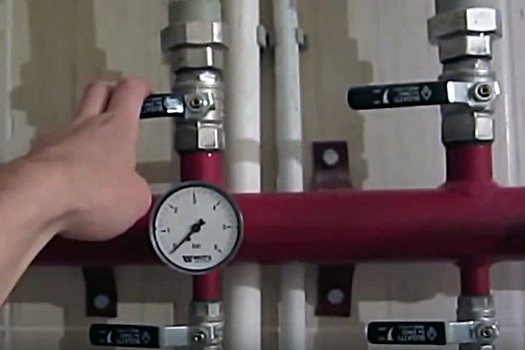

Begin by observing the pressure transducer mounted on the manifold that directs the water from your boiler to the various circuits of the hidden pipe. If you have information about the typical pressure in the system, which was supposed to be provided by the floor heating installer or the technician who maintains the system, you can compare the readings and determine if the pressure in the system is dropping. Most systems maintain pressures between 0.7 and 1.7 bar, but this depends on the design and pipe spacing. Low pressure is a clear indicator of a leak, so a system with a pressure gauge reading of 0 bar certainly needs immediate attention.
Looking for a reason
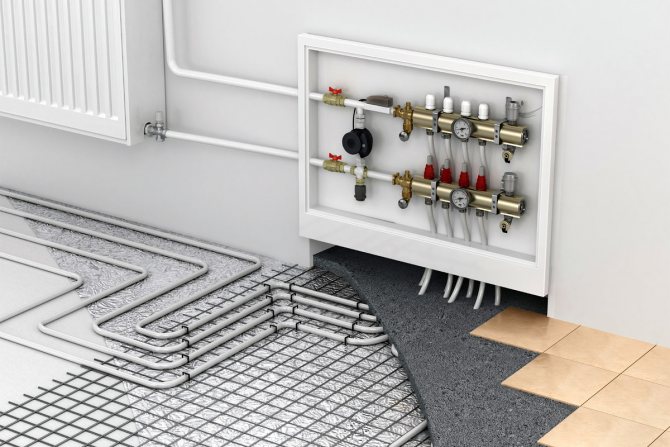

If you are planning to install underfloor heating in your home, it is important to familiarize yourself with the information about possible malfunctions and how to fix them. This will help to take the correct and timely measures in advance, eliminate many risk factors and, most importantly, think it over so that you can easily eliminate a possible breakdown.
To do this, study the main elements of a warm floor, namely:
- Pipes - highways.
- Bypass.
- Circulation pump.
- Collector and electric drives.
- Thermostats and thermostats.
- You also need to take into account possible errors when installing a warm floor. For example, insufficient insulation or incorrect thickness of the insulating material.It is quite problematic to cope with such a problem. We'll have to lift all the flooring, dismantle the screed and pipes. Therefore, when buying all the components, be sure to consult with specialists. They will help you choose the right material, as a result of which the warm water floor will work for at least 40 years without failure.
If stopped working
What to do if the water floor stops working and does not heat the surface in any way? This can be caused by the following problems:
- Airing the system.
- Circulation pump.
- Mechanical damage.
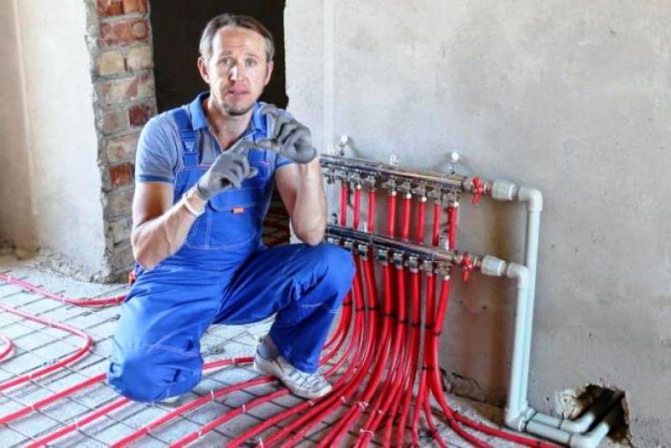

If it does not work well
Poor operation of the heating system can be provoked by:
- Uneven distribution of the coolant in the circuits.
- Cluttered furniture.
- Choosing the wrong cable.
- Insufficient power level of boiler equipment.
- Poor quality vapor barrier material.
How to find a water leak in a warm floor if a pipe is broken?
If there is a scheme for laying pipes for underfloor heating, then it will not be difficult to find a water leak. Where great difficulties can arise with the removal of floor finishing materials and with the installation of the coupling. It is with the coupling that the punched pipe of the warm floor should be connected if it has been damaged during operation.
Certain difficulties with finding leaks can arise if there are absolutely no floor heating wiring diagrams at hand. In this case, you can act in reliable and proven ways.
In order to find water leaks, you should use automotive fluid, which is poured into the car washer reservoir. This tool contains special dyes, and it is they that will help find the place where the warm floor was broken.
To use this method, in addition to the "colored" liquid, you will also need a pressure pump. What is a pressure test pump? This is a special device that makes it possible to fill the heating system with water, air or antifreeze, in the absence of electricity or the required water pressure in the water supply.
To find a leak, you will need to shut off all circuits on the underfloor heating comb, and then separately press them with a liquid with dye. During this procedure, all the time you need to observe in which part of the room a colored spot appears. Of course, such a way to find a leak in a warm floor is not entirely ideal, but this is already something from which you can start looking for damaged places.
In addition to a special liquid, you can find a leak in the pipes if you fill them not with water or a special agent, but with ordinary air. To do this, you need to perform all the same manipulations: close the contours of the warm floors, and then begin to pressurize them with air, separately. In the place where the pipe is damaged and repair of the warm floor is required, an air jet will burst out with noise.
Finding leaks in a warm floor with a thermal imager
A special device - a thermal imager will also help to detect a leak in a warm floor. If you look at the warm floor, when it is working, through a thermal imager, you can see exactly how the pipes of the circuits are located. Consequently, a warm water leak will be visible as a large red spot on the thermal imager.
The only problem on the way of detecting leaks in a warm floor with a thermal imager can be a thick screed, more than 12 cm, and a glossy floor covering. From such a surface, the beam of the thermal imager is simply reflected, and does not make it possible to track any temperature fluctuations on the floor surface.
To avoid problems with the operation of warm floors, you always need to have a plan for laying pipes, with their exact location and distance from walls, doors and plumbing fixtures. The customer has the right to demand such a scheme from the installers in order to provide it to the master finishers who will install the floor covering in the future.
Rate the article and share the link:
The underfloor heating circuit does not work
So, if the underfloor heating circuit does not work for you, you need to view in the distribution box all ball valves for each circuit, which should be open, i.e. located along the pipelines.
Laying a warm water floor
It is also possible that the circulation pump is out of order. Most often it is located in the switchboard near the boiler.
Listen and if you hear a little noise or feel a little vibration, then everything is in order with the circulation pump, if not, then it will need to be replaced. But, before replacing this part, check if voltage is supplied to it.
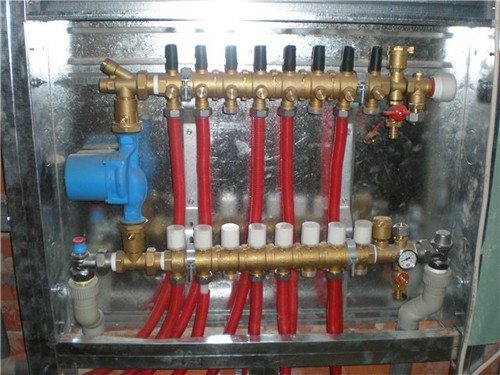

Manifold cabinet for warm water floor with pump
Perhaps, warm water floors do not heat due to burnt-out electrical wiring, so it is worth checking it first. The third reason for the lack of functioning of the circuit may be the presence of air in the system. In this case, you need the help of specialists who can pressurize the system using special equipment. By the way, you can do the crimping yourself if you have this special equipment at hand. It can usually be rented from any store that sells warm water floors.
It will also require repair of water heated floors if they have a low temperature, which is not enough to heat the space of the room. There may be several reasons for this. The first of which is the lack of the required boiler power. Here, as an option, you can try to lower the temperature in other rooms - where you are a little less often. Perhaps it's time to clean the boiler, revise the temperature sensors, or carry out preventive repairs.
The second reason can be furniture in the room. Carpets, sofas and wardrobes can have a significant effect on room temperature.
Insulation for warm water floor
Underfloor heating requires open floors, and the more, the better.
Or it may be necessary to repair the underfloor heating thermostat, often it is the thermostat that is the cause of the low temperature in the premises.
Thermoregulator for warm water floor
It is possible that problems with a warm floor arose due to the fact that they saved on insulation. In this case, you heat either the neighbors or the soil. Here you need to decide whether to use additional sources of heating the room, or completely redo the heating system. That is why, before installing the underfloor heating system, it is necessary to carefully think over the project and carry out the installation either yourself, but as seriously as possible, or entrust this responsible matter to professionals who will install the warm water floor in the shortest possible time.
